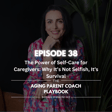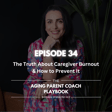
Episode 14: Building on a Strong Foundation: Secure Attachment and Caring for Aging Parents
Welcome back to The Aging Parent Playbook, the podcast where we tackle the emotional and practical challenges of caring for aging parents with compassion, support, and actionable advice. I’m your host, Dr. Barbara Sparacino, and today we’re talking about secure attachment and how it shapes your caregiving journey.Secure attachment is often considered the “gold standard” in relationships, but even with a strong foundation, caregiving comes with its challenges. Today, we’ll explore what secure attachment looks like, how it impacts caregiving, and ways to navigate the journey with confidence and grace.Segment 1: What Is Secure Attachment?
Let’s start with the basics. Secure attachment develops when caregivers in your childhood were consistently reliable and responsive. You learned that the world was a safe place and that your needs would be met.Fast-forward to adulthood, and securely attached individuals often have healthy relationships where they’re comfortable with both emotional closeness and independence. You’re the type who can handle tough conversations, set boundaries, and ask for help when needed.Sounds like a caregiving superpower, right? But even with a secure attachment style, caregiving for aging parents can push you to your limits.Segment 2: How Secure Attachment Helps in CaregivingBarbara:
Securely attached individuals have a few natural strengths that make caregiving smoother:
- Balance: You’re good at balancing your parent’s needs with your own.
- Emotional Resilience: You can manage tough emotions like grief or frustration without being overwhelmed.
- Effective Communication: Whether it’s with doctors, family members, or your parent, you’re clear and assertive.
Let me share an example.Story of Rebecca:
Rebecca is in her late 40s, working full-time and raising a teenager, all while caring for her aging father who has Parkinson’s. Her secure attachment allowed her to approach caregiving thoughtfully.When her dad had a rough day and snapped at her, Rebecca didn’t take it personally. She calmly said, “Dad, I see you’re frustrated. Let’s figure this out together.” Later, she processed her emotions by journaling and talked with her husband about her feelings.Rebecca’s ability to balance her dad’s needs with her own emotional health made a big difference.Segment 3: Challenges of Secure Attachment in CaregivingBarbara:
Even with secure attachment, caregiving isn’t always easy. Some challenges include:
- Overconfidence: You might take on too much, thinking, “I can handle this.”
- Emotional Fatigue: Being open to emotions can lead to exhaustion.
- Perfectionism: You might feel pressure to “get it right” all the time.
Segment 4: Practical Tips for Securely Attached CaregiversBarbara:
Here are some tips to help you navigate caregiving: Set Boundaries Early: Don’t wait until you’re burned out. Schedule regular breaks or delegate tasks.
Practice Self-Compassion: You’re not going to get everything right, and that’s okay.
Ask for Help: Whether it’s from siblings, friends, or professional caregivers, lean on your support system.ClosingBarbara:
Secure attachment provides a strong foundation, but caregiving is a journey of constant learning and adaptation. By staying self-aware and compassionate, you can show up for your parents in a way that feels meaningful and sustainable.If you found this episode helpful, please subscribe and share it with someone who might benefit. For personalized support, check out my coaching programs at TheAgingParentCoach.com.Take care, and remember—you’ve got this.



















